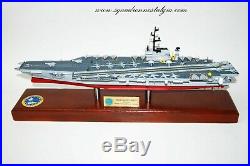

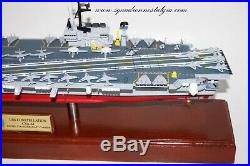
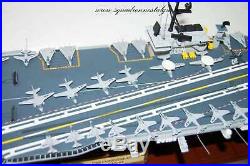
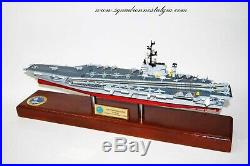
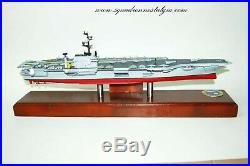



CV-64 USS Constellation Aircraft Carrier Model. Fly off of the CV-64 USS Constellation Aircraft Carrier Model in this handcrafted wooden model. Each model is carved from wood and handcrafted to provide a piece you’ll love. One of the fastest ships in the Navy, as proven by her victory during a battlegroup race held in 1985, she was nicknamed “Connie” by her crew and officially as “America’s Flagship”. The contract to build Constellation was awarded to the New York Naval Shipyard Brooklyn, New York, on 1 July 1956, and her keel was laid down 14 September 1957 at the New York Navy Yard. She was launched 8 October 1960, sponsored by Mary Herter (wife of Secretary of State Christian Herter). Constellation was delivered to the Navy 1 October 1961, and commissioned on 27 October 1961, with Captain T. [3] Constellation was the last U. Aircraft carrier (as of 2016) to be built at a yard other than Newport News Shipbuilding & Drydock Company. Constellation was scrapped at Brownsville, Texas, in 20152017. USS Constellation was heavily damaged by fire while under construction on 19 December 1960. The carrier was in the final stages of construction at the Brooklyn Navy Yard in Brooklyn, New York when the fire began. The fire broke out when a forklift operating on the hangar deck accidentally pushed its cargo into a steel plate knocking it over. The fuel was ignited perhaps by a cutting torch of a fitter, and then moved to a wooden scaffolding. A Navy commander commented on the nature of the ships design at an inquiry, Ships of this class are the most complex structures ever designed by man. It took 17 hours for firefighters to extinguish the fire, some of whom had been “driven to the raw edge of exhaustion” after being called into service in the Park Slope air accident. The firefighters saved hundreds of lives without losing any of their own, however fifty shipyard workers perished. 19601969 Constellation was launched 8 October 1960, and she was delivered to the Navy 1 October 1961. She was commissioned on 27 October 1961, with Captain T. [2] Another fire occurred on the Constellation on 7 November 1961, while she was being tested at sea, killing four and injuring nine others. Following fitting out and acceptance trials, Constellation departed her home port of Norfolk, Virginia, on 7 February 1962 for initial air operations off the Virginia Capes. She conducted her first catapult launch and arrested landing the same day with Commander George C. Watkins, air group (CVG) 13 commander, at the controls of an A4D-2 Skyhawk of Attack Squadron 34. After a month of operating locally, Connie (as the carrier became known) conducted a two-month shakedown cruise in the Caribbean Sea. In summer 1962, Constellation was transferred to the U. Pacific Fleet and CVG-13 was disestablished. For the two-month trip around Cape Horn to her new home port of San Diego, California, Connie embarked elements of CVG-5 and departed Mayport, Florida, on 25 July. In November Constellation, with CVG-14 on board, commenced workup exercises for her upcoming maiden deployment to the western Pacific as a component of the U. The uneventful cruise took place from February to September 1963. Constellation’s second deployment began on 5 May 1964. She relieved Kitty Hawk on station in the Gulf of Tonkin off Vietnam on 8 June, embarked Carrier Air Wing (CVW) 14 (air groups had been redesignated air wings on 20 December 1963) and flew armed photo reconnaissance missions over Laos until 13 July. Following an upkeep period at Subic Bay, Philippines, Constellation reached Hong Kong for a port visit on 27 July, but within a few days was called back into action. As a result of orders received during the first day of the Gulf of Tonkin Incident (2 August 1964), Constellation got underway and headed toward the Gulf of Tonkin. On 4 August, Constellation launched F-4B Phantom IIs to join aircraft from Ticonderoga in providing air cover over the destroyers which were alleged by the Johnson administration to have been attacked by North Vietnamese torpedo boats. On 5 August both carriers launched Operation Pierce Arrow, a series of air strikes on a North Vietnamese oil facility and naval vessels. CVW-14 lost two aircraft, an A-1 Skyraider, piloted by Lieutenant (junior grade) Richard C. Sather, who was killed in action (KIA), and an A-4 Skyhawk flown by Lieutenant (junior grade) Everett Alvarez, Jr. Who became one of the United States’ first prisoners of war (POW) of the Vietnam War. Connie and CVW-14 were awarded a Navy Unit Commendation (NUC) for the early August operations. During the deployment, Constellation appears to have been under the direction of Commander Carrier Division 9. A first shipyard period for Constellation followed, lasting eight months; then workups commenced for her first full-blown war cruise. The carrier, with CVW-15 on board, was underway for operations off Vietnam in May 1966. During 111 days on station, aircraft from Constellation pounded roads, bridges and other targets, attempting to impede the flow of men and war materials south. The F-4B aircrew of pilot Lieutenant William M. McGunigan and radar intercept officer Lieutenant (junior grade) Robert M. Fowler from Fighter Squadron 161 (VF-161) shot down a MiG-17 fighter jet on 13 July, marking the ships first MiG kill of the war. Subsequently, both Constellation and CVW-15 were awarded a NUC for this deployment. After a short workup cycle, Constellation’s third combat deployment commenced in April 1967. With CVW-14 embarked, the carrier operated first on Dixie Station a patrol area about 60 miles (97 km) off South Vietnam with strikes in the Iron Triangle region, and then moved north to Yankee Station a patrol area about 50 miles (80 km) off North Vietnam for a total of 121 days on the line. Reflecting the intensive nature of air operations, F-4Bs of VF 142 and VF 143 accounted for four MiG kills. The eight-month deployment ended in December, having totaled losses of 16 aircraft and 20 personnel, including seven KIAs and eight POWs. Both the carrier and CVW-14 received a NUC. Constellation began her fourth deployment to the western Pacific and Vietnam on 29 May 1968. During this deployment, the Constellation/CVW-14 team was restricted to strikes below the 20th parallel of North Vietnam as a result of a March Presidential order. On 1 November, as directed by President Johnson, all bombing of North Vietnam was halted at 21:00 Saigon time. The last Navy mission over the restricted area was flown earlier in the day by Cmdr. Enney in an A-7 Corsair II. Fifteen aircraft were destroyed, nine due to enemy action. Six aircrew members perished, five were listed as KIAs and three were taken as POWs. By August, it was time for Connie to return to Vietnam for a fifth combat deployment, again with CVW-14. Following an initial 20-day period of supporting strikes in South Vietnam as well as Laos, Constellation sailed to Defender Station in the Sea of Japan, which had been created as a result of increased tensions on the Korean Peninsula. [2] On 2 October 1969, there was an accident causéd when the tail rotor came off of a helicopter just before landing on the flight deck. Nine men went down with the chopper and were never recovered. [citation needed] A return to Yankee Station on 1 November also produced a major milestone in the carrier’s life when the F-4J aircrew of air wing skipper Commander R. Billings and Lieutenant (junior grade) Jeff Taylor of VF-143 conducted Connie’s 100,000th arrested landing. During a mission on 28 March 1970, the VF-142 F-4 crew of Lieutenant Jerome E. Beaulier and Lieutenant Steven J. Barkley downed a North Vietnamese MiG-21 jet fighter. Following a total of 128 days on the line, Connie’s nine-month deployment ended in May, with CVW-14 suffering the loss of seven total aircraft, five to enemy action. One member of the aircrew was taken as a POW, but there were no fatalities. 19701979 Upon her return Constellation began a nine-month major shipyard overhaul, her second since commissioning. In spring 1971 she welcomed aboard a new air wing, CVW-9, and departed San Diego on 1 October for what would become a historic combat deployment. Air operations commenced with strikes against mainly logistic targets in Laos as well as reconnaissance missions over North Vietnam into 1972. On 19 January, the VF-96 F-4 Phantom crew of Lieutenant Randall H. “Duke” Cunningham and Lieutenant (junior grade) William P. Driscoll scored a kill against a MiG-21, the first for a Navy aircraft since Connie’s VF-142 kill on 28 March 1970. The carrier was nearing the end of her scheduled deployment when her tour was extended to meet the threat posed by the North Vietnamese Easter Offensive. Initial air strikes in support of ground troops were followed by a new, more intensive series of air strikes against major targets in North Vietnam. On 8 May, the same VF-96 aircrew team of Cunningham and Driscoll scored against a MiG-17. Then on 10 May, Cunningham and Driscoll downed three MiG-17s, becoming the first aces of the Vietnam war. Three more MiG-17s were downed by two other VF-96 crews, two by Lieutenant Michael J. Connelly and Lieutenant Thomas J. Blonski and one by Lieutenant Steven C. Shoemaker and Lieutenant (junior grade) Keith V. Adding to the score, VF-92 aircrew Lieutenant Curt Dose and Lieutenant Commander James McDevitt shot down a MiG-21. All told, Constellation fliers shot down seven MiGs on 10 May. The nine-month deployment ended on 1 July, the carrier having spent 154 days off Vietnam. Seven aircraft were lost, two aircrewmen were reported KIA and two became POWs. The Constellation/CVW-9 team received the Presidential Unit Citation for their outstanding efforts. Constellation was the focus of media attention when black members of her crew protested what they saw as disparate treatment by the Navy, leading to what some saw as an aborted mutiny in late 1972. Constellation’s commanding officer ordered administrative (less than honorable) discharges for five black sailors he considered troublemakers. He planned to give early discharges to another 250 men whose enlistments would expire while Constellation was overseas. While Constellation was conducting exercises off the California coast, a rumor started that the captain was going to give 250 less than honorable discharges to black sailors. On 1 November, black sailors waylaid a white mess cook in a passageway and broke his jaw. The captain scheduled an open meeting for 21:00 3 November to clarify the 250 planned discharges. At noon 3 November a group of 50 black sailors began a sit-in on a portion of the mess deck. The remaining sailors sat down on the dock to be filmed by television crews and were ultimately transferred to shore stations for mast. Twelve received general discharges, 35 were honorably discharged but not recommended for re-enlistment, and 73 received punishments ranging from loss of pay and reduction in rate to warnings prior to being reassigned to sea duty. In January 1973, Constellation headed back to Southeast Asia. The Paris Peace Accords took effect on 28 January, but CVW-9 aircraft continued to strike targets in Laos until a cease-fire in that country was called on 21 February. Thus Connie, which had been on station at the beginning of combat operations in Vietnam in 1964, was on station at the end, nine years later. The remainder of the nine-month deployment consisted largely of flights in support of mine-clearing operations in North Vietnam. Upon her return in October 1973, Constellation enjoyed a nine-month workup cycle, and departed in June 1974 for her first peacetime deployment in 10 years. On 23 November, she became the first carrier to enter the Persian Gulf since 1949. The six-month cruise ended on 24 December 1974. A 14-month major overhaul and upgrade at Puget Sound Naval Shipyard, Washington, commenced in February 1975, during which Constellation was modified to reflect the Navy’s new multipurpose air, surface and antisubmarine warfare role for carriers. She was redesignated a CV on 30 June 1975. With the overhaul completed in April 1976, Connie could now operate both the new S-3A Viking and F-14A Tomcat. However, the workups uncovered problems, and a 26-day drydocking in late 1976 at Long Beach Naval Shipyard, California, was required. The highlight for the remaining workup cycle was participation in Rim of the Pacific (RIMPAC) multinational exercises held in and around the Hawaiian Islands. An uneventful April to November 1977 deployment, Connie’s tenth, to the Far East followed. Constellation’s next deployment, from September 1978 to May 1979, was originally scheduled to end in March but was extended due to her sortie into the Indian Ocean in reaction to a political crisis in Yemen. Following a relatively short eight-month turnaround cycle, she was underway again in February 1980 under the command of Captain Leon Edney, USN. After participating in RIMPAC exercises, Constellation steamed westward to the Arabian Sea, where Gonzo Station had been established following the November 1979 takeover of the American Embassy in Tehran, Iran. Connie had reached the eastern Indian Ocean when the unsuccessful 24 April 1980 raid to free American hostages took place, and she relieved Coral Sea on Gonzo Station on 1 May. This at-sea period would last a record-setting 110 days. As a result, the crew of Constellation was awarded the Navy Expeditionary Medal for their service. The deployment ended in mid-October. During the 1981 workup cycle President Ronald Reagan visited Constellation on 20 August 1981 and proclaimed the carrier “America’s Flagship” while presenting the crew a presidential flag and announcing to the crew: Let friend and foe alike know that America has the muscle to back up its words, and ships like this and men like you are that muscle. Under the command of Captain Dennis M Brooks USN Constellation sailed to the western Pacific and Indian Ocean from October 1981 to May 1982. Connie deployed from February to August 1985 with CVW-14 embarked, marking the first deployment for the F/A-18. As preparations for a 1987 deployment proceeded, it was announced that Constellation had earned the coveted Pacific Fleet Battle Efficiency Award (Battle Efficiency E) for the 18-month period ending on 30 June 1986. As a result, the crew of Constellation was awarded the Armed Forces Expeditionary Medal for their service. On the morning of 2 August 1988 Connie quietly slipped her moorings for a routine two-week carrier qualification off the coast of southern California. Things quickly turned out to be anything but routine. The Fuel Oil Supervisor and Oil Lab were blamed early on even though they were not transferring fuel at the time. One Main Top Watch (a Boiler Technician) triggered the halon fire suppression system as he exited the space. Unfortunately the standard procedure was to wait 30 minutes after Halon had been triggered to re-enter the space. When the crew re entered the space was still hot and reignited the fire. Through the damage control efforts of her crew, Connie. S main fires were extinguished around 2100 at which time Marines served hot dogs to the exhausted crew in the hangar bay. To the crew’s horror, the fires reflashed and the crew went back into action. During the conflagration, an over-temperature alarm sounded for the Mt. 23 CIWS 20 mm ammunition magazine. This necessitated the firecontrolmen offloading the magazine contents over the side because low firemain pressure precluded flooding the magazine to cool it. Mt 23 was situated on the port side of the island just forward of the boiler uptakes. After the long battle fighting the main space and collateral fires, there were no fatalities. There were however some serious injuries ranging from broken bones to smoke inhalation. [citation needed] Connie pulled back into North Island on 3 August. The subsequent investigation showed that there was a problem with a JP-5 pipe leading to a fuel station that wasn’t adequately inspected after an in-port maintenance availability period. The problem was that a pipe that had long ago been removed that uséd to pass through the uptakes was hooked back up. The 6-to-8-inch (150 to 200 mm) pipe in the uptakes just emptied into the uptakes where 1MMR’s 6 forced draft blowers sucked the fuel into the running boilers. The total amount of JP-5 pumped into the uptakes was approximately 20,000 gallons. The Constellation/CVW-14 team deployed on 1 December 1988 for the Indian Ocean. She left port on three screws with the final repairs to the fourth screw being completed at Subic Bay, Philippines. Four days out to sea, a Prowler and its four crew members were lost at sea. This West-Pac deployment ended six months later at San Diego on 1 June 1989. With CVW-9 embarked, Connie departed San Diego on 12 February 1990 for the East Coast. Following exercises with the air forces of several South American countries, including Gringo-Gaucho with the Argentine Navy, while en route and preparations at Norfolk, Virginia, Constellation entered Philadelphia Naval Shipyard, Pa. Completed in March 1993, the SLEP was a cross between new construction and a comprehensive overhaul, designed to add 15 years to the carrier’s operational life. Constellation conducted her post-SLEP shakedown with a number of CVW-17 squadrons, and then moored at Mayport, Florida, on 8 April. With CVW-2 assigned, Connie departed Mayport on 29 May and conducted exercises with various South American air forces while en route to San Diego, where she arrived on 22 July 1993. During MayJune 1994 Connie and CVW-2 participated in RIMPAC exercises, and on 10 November departed San Diego for an extended deployment for the first time in six years. Exercises off Okinawa were followed by a number of exercises off Korea region that had once again become the focus of world attention with the news that North Korea was attempting to develop nuclear weapons. On 11 January 1995, the Constellation battle group entered the Persian Gulf to take up station in support of Operation Southern Watch (OSW), enforcing the no-fly zone over southern Iraq. The six-month deployment concluded with her return to San Diego on 10 May. Effective 1 October 1995, Constellation was assigned to Cruiser-Destroyer Group 1. Constellation’s next deployment, from 1 April to 1 October 1997, included a return to the Persian Gulf for Southern Watch, now under control of the United States Fifth Fleet. In over 10 weeks of operating in the Gulf, CVW-2 flew more than 4,400 sorties, with well over 1,000 Southern Watch sorties. Constellation departed San Diego on 18 June 1999 for the Korean Peninsula to monitor the situation. On 28 August, she entered the Persian Gulf and in ten weeks conducted more than 5,000 sorties and 1,256 OSW sorties. This period was highlighted by air strikes against two Iraqi radar stations and an attempt by VF-2 to engage an Iraqi jet with the long-range Phoenix air-to-air missile on 14 September. CVW-2 aircraft engaged in nine specific ordnance-dropping air strikes while in the Persian Gulf. The battle group departed the Persian Gulf on 5 November, and she arrived home for the holidays on 17 December. At the year’s end, Constellation was awarded her second Battle Efficiency E as the Pacific Fleet’s best carrier for the 12-month reporting period. Constellation’s 20th deployment began on 16 March 2001. She entered the Persian Gulf on 30 April and immediately commenced operations in support of OSW. On 13 May, Captain John W. Miller[15] assumed command as Connie’s 30th skipper, and her last. She ceased OSW operations on 4 August, having conducted multiple air strikes in response to Iraqi violations of the no-fly zone. On 11 September Constellation was nearly halfway between Pearl Harbor and San Diego when word was received of the terrorist attacks on New York and the Pentagon. Despite discussions about turning the battle group around, the carrier was allowed to complete her regularly scheduled deployment. Connie arrived in San Diego on Friday 14 September and celebrated her 40th birthday the next month. Following an abbreviated turnaround cycle, Constellation prepared for her final deployment and the opportunity to fight in the Global War on Terrorism. She departed on 2 November 2002, leading Cruiser-Destroyer Group 1 under the command of Rear Admiral Barry M. She was soon supporting Operation Enduring Freedom; on 17 December she entered the Persian Gulf to begin OSW missions. On 19 March 2003, with two carriers in the eastern Mediterranean and three in the gulf, Operation Iraqi Freedom commenced. Connie was designated a night carrier and remained on station throughout the major ground combat phase. She launched more than 1,500 sorties and CVW-2 aircraft delivered over 1.7 million pounds (770,000 kg) of ordnance. While one aircraft was lost in an operational mishap, there were no fatalities. Connie departed the gulf on 17 April and steamed for San Diego for the last time. On 1 June a Sea Control Squadron 38 (VS-38) S-3B Viking crewed by Lieutenant Hartley Postlethwaite, Lieutenant (junior grade) Arthur Gutting and Constellation Commanding Officer, Captain John W. Miller, recorded Constellation’s 395,710th and final arrested landing. Her 21st and final deployment ended the next day. Constellation was replaced by USS Ronald Reagan. After 41 years of commissioned service, USS Constellation was decommissioned at the Naval Air Station North Island in San Diego on 7 August 2003. Constellation was placed in Reserve Category X, meaning it received no maintenance or preservation, and only security against fire, flooding, and pilferage was provided. Reserve Category X applies to ships that have been stricken and are awaiting disposal by scrap, sale to foreign countries, as a designated target in a live fire exercise, memorial, or donation, as applicable. According to news reports in February 2008, Constellation was scheduled to be disposed of by dismantling in the next five years, along with USS Independence. As of 26 January 2012, the Navy’s Naval Sea Systems Command posted a notice of solicitation for the towing and complete dismantlement of multiple CV-59/CV-63 Class Aircraft Carriers in the United States, to include ex-Forrestal, ex-Independence, and ex-USS Constellation. Constellation was scrapped at Brownsville, Texas starting in early 2015. She was towed around Cape Horn on her final voyage. The carrier arrived at its final resting place in Brownsville on 16 January 2015. Scrapping was complete on 10 May 2017 when the last propeller shaft strut was pulled from the water. Constellation appears in the 2001 film Pearl Harbor, portraying USS Hornet during the takeoff sequences for the Doolittle Raid. Only the forward part of the flight deck is shown, to mimick the straight deck of Hornet, though the two steam catapults are clearly visible. Some members of the crew were uséd as extras in the movie. She was also featured prominently in the first episode of the sixth season of the sitcom Home Improvement. The episode was titled At Sea. Sorry, our items are NOT available for pick-up. No additional information at this time. You might also like. VF-103 Jolly Rogers F-14b Model. VP-8 Fighting Tigers Plaque. VP-16 War Eagles Plaque. The item “CV-64 USS Constellation Aircraft Carrier Model” is in sale since Wednesday, February 20, 2019. This item is in the category “Collectibles\Militaria\Current Militaria (2001-Now)\Original Items\Patches\Navy”. The seller is “madfoxpilot” and is located in Powhatan, Virginia. This item can be shipped to United States.
